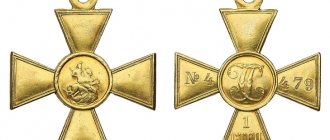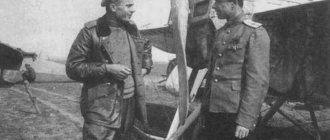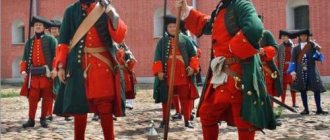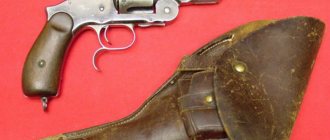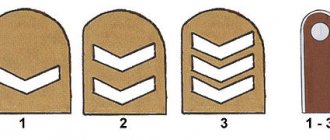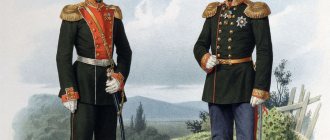The history of the Russian army is an integral part of Russian culture, which is necessary for everyone who considers himself a worthy son of the great Russian land to know. Despite the fact that Rus' (later Russia) waged war throughout its existence, the specific division of the army, the assignment of a separate role to each of its components, as well as the introduction of appropriate distinctive signs began to occur only during the time of the emperors. The infantry regiments, the indestructible backbone of the empire's armed forces, deserved special attention. This type of troops has a rich history, since each era (and each new war) introduced colossal changes to them.
Shelves of the new order (17th century)
The infantry of the Russian Empire, like the cavalry, dates back to 1698 and is a consequence of the army reform of Peter 1. Until that time, rifle regiments prevailed. However, the emperor’s desire not to be different from Europe took its toll. The number of infantry amounted to more than 60% of all troops (not counting the Cossack regiments). War with Sweden was foreshadowed, and in addition to the existing soldiers, 25 thousand recruits were selected and undergoing military training. The officer corps was formed exclusively from foreign military personnel and people of noble origin.
The Russian military was divided into three categories:
- Infantry (ground forces).
- Land militia and garrison (local forces).
- Cossacks (irregular army).
In total, the new formation amounted to about 200 thousand people. Moreover, infantry stood out as the main type of troops. Closer to 1720, a new rank system was introduced.
Special troops
Special troops that are part of the Ground Forces are capable of solving various tasks that arise during combat operations. The Ground Forces have a significant number of special forces:
- Chemical Defense Troops;
- Railway Troops;
- Automotive Troops;
- Signal Corps;
- Road Troops;
- Pipeline Troops;
- Corps of Engineers.
All these types of troops are designed to solve logistics problems that inevitably arise in military conflicts of any scale. The supply of ammunition, food, provision of communications and communications - this is not a complete list of tasks that the special forces that are part of the Ground Forces of the Russian Federation solve.
Modern Russian Ground Forces have begun to modernize at an accelerated pace in recent years. The prestige of military professions is rising, as a result of which more and more young people want to connect their lives with the Russian army.
Changes in weapons and uniforms
The uniform and weapons also underwent changes. Now the Russian soldier fully corresponded to the image of a European military man. In addition to the main weapon - a gun, the infantrymen had bayonets, swords and grenades. The material for the mold was of the best quality. Great importance was attached to its tailoring. From this time until the end of the 19th century, there were no significant changes in the Russian army. Apart from the formation of elite regiments - grenadiers, rangers, etc.
Black berets
Among all types of infantry, I would like to see the Marine Corps. This is a clear example when all other types of troops help the infantrymen. Airplanes clear the shore, ships cover the landing with their artillery, marines on floating armored personnel carriers reach the shore and take control of the coastal strip or begin to move inland.
Among the branches of the Russian Navy, the Marine Corps is the most combat-ready unit. These are mobile, well-armed, trained and versatile troops, ready to carry out any task. They can only be compared with the Airborne Forces. Marine units have repeatedly proven their training and strong-willed qualities, defending the interests of the Russian people and state.
In 2015, November 27, the 310th anniversary of the creation of the Marine Corps was celebrated. In this regard, many events were held, especially in cities where black berets serve, for example, in the Kaliningrad region. On May 9, not only current employees, but also veterans marched in a parade. So in every city in Russia, the Marine managed to show off in his black uniform!
Infantry in the War of 1812
In view of the upcoming events (Napoleon Bonaparte's attack on Russia), which became precisely known from intelligence reports, the new Minister of War Barclay de Tolly, recently appointed to this post, considered it necessary to make massive changes in the Russian army. This was especially true for infantry regiments. In history, this process is known as the military reforms of 1810.
The infantry of the Russian Empire at that time was in a deplorable state. And not because there was a shortage of personnel. The problem was organization. It was precisely this moment that the attention of the new Minister of War was devoted to.
Battle of Loudoun Hill 1307
The main source for this battle is the metrical History of Robert the Bruce , written by the Archdeacon of Aberdeen John Barbour , the actual description is given in the eighth book. Englishmen under the leadership of Wales Eimar , but there were significantly fewer Scots - only 600 infantrymen. To what extent these figures correspond to reality is an open question; most likely, the assessment of the Scots can be trusted, but there were clearly fewer Englishmen. Perhaps Valens had about 1200-1500 warriors, of which about 1000-1200 were infantry and 200-300 horsemen. But even such a force was radically superior to the Scots. Robert the Bruce, fearing an attack from the flank and rear, shortened the front by digging two ditches, so that no more than 500 knights could attack him head-on. Eimar gave an inspiring speech, and the horsemen went on the attack [16]:
With their heads bowed and their spears thrust forward, they rushed straight at the king [Robert the Bruce]. And he met them with such force that the best and bravest were thrown to the ground by the impact. There was such a roar and crack of spears, such screams and screams of the wounded that it was scary to hear them.
Almost the entire field was strewn with dead horses and people.
After which 500 of Bruce's warriors go on the attack, and the English army takes flight. British losses are estimated at 100 knights, which suggests that up to half of all Eimar's horsemen were killed in the attack.
Preparation of the army of 1812
Preparatory work for the war with France was presented in a memorandum entitled “On the protection of the western borders of Russia.” It was approved by Alexander 1 in 1810. All the ideas outlined in this document began to be translated into reality.
The army's central command system was also reorganized. The new organization was based on two points:
- Establishment of the War Ministry.
- The establishment of command and control of a large active army.
The Russian army of 1812, its condition and readiness for military action were the result of 2 years of work.
Infantry structure 1812
The infantry made up the majority of the army and included:
- Garrison units.
- Light infantry.
- Heavy infantry (grenadiers).
As for the garrison component, it was nothing more than a reserve of the ground unit and was responsible for the timely replenishment of the ranks. The force also included Marines, although command of these units was exercised by the Department of the Navy.
Replenishment of the Lithuanian and Finnish regiments organized the Life Guards. Otherwise they were called elite infantry.
Composition of heavy infantry:
- 4 guards regiments;
- 14 regiments of grenadiers;
- 96 regiments of foot troops;
- 4 Marine Regiments;
- 1st battalion of the Caspian fleet.
Light Infantry:
- 2 guards regiments;
- 50 regiments of rangers;
- 1 naval crew;
Garrison troops:
- 1 garrison battalion of the Life Guards;
- 12 garrison regiments;
- 20 garrison battalions;
- 20 battalions of internal guards.
In addition to the above, the Russian army included cavalry, artillery, and Cossack regiments. Militia formations were recruited in every part of the country.
US ARMY LIGHT INFANTRY
Responding to the full range of crisis situations involves the participation of US military forces in various types of military operations - from providing humanitarian assistance to conducting theater wars, conducting several simultaneous operations of a smaller scale, such as a show of force and invasion of enemy territory, launching limited strikes, regime of economic sanctions and the definition of no-fly zones, conducting peacekeeping and humanitarian operations, evacuating civilians in the event of dangerous situations, combating international terrorism, drug trafficking, etc.
Soldiers of the 7th Light Infantry Division of the US Army - 80s of the last century |
The successful implementation of these provisions of the national military strategy, in the opinion of the US military leadership, requires the presence in the armed forces of a small number of special forces with appropriate training and equipment. These primarily include special operations forces and light infantry units.
The creation of regular and special forces units in the US armed forces began on the eve of World War II, and was then accelerated during the Vietnam War. The concept of “special forces” was used in American military terminology until the mid-1980s. Since 1985, in all official documents these forces have been called Special Operations Forces (SSO).
Today, the Special Operations Forces of the US Armed Forces are specially created, trained and equipped formations of three branches of the armed forces (ground forces, air force and navy), designed to solve specific problems in the interests of achieving political, economic and military goals in foreign territories. Their total number exceeds 45,000 people. MTR units are kept in constant readiness for immediate use. Thus, in 1991, special operations forces were involved in solving problems in 92 countries, and in 2000 - already in 152. Currently, about 5,000 SOF personnel perform tasks in 60 countries of the world every week.
The MTR of the US Ground Forces has units and units of various profiles: the Green Berets (army special forces), the Delta detachment, specializing in countering terrorism and drug trafficking, the 160th air regiment "Night Stalkers" (a helicopter unit providing the air component of special operations) , units of psychological warfare, civil administration and others. Also in the structure of the US SOF there is a unit that is similar in structure, armament and tasks to light infantry - the 75th Ranger Regiment. But let's move directly to the light infantry units of the US Army.
The regular US Army has two light infantry divisions , as well as an airborne division and an air assault division (the latter is transported by helicopter). The United States National Guard has another light infantry division , as well as a light infantry brigade .
What is the American light infantry like today?
The light infantry division is a qualitatively new type of combined arms formation of the US ground forces. It is designed for rapid airlift to conduct maneuverable combat operations in difficult physical and climatic conditions on very rough terrain, where the use of tank and mechanized formations is difficult or practically impossible, as well as to support and develop MTR operations.
Organizationally, a light infantry division (LPD) includes: a headquarters and a headquarters company, three brigade headquarters with headquarters companies, nine infantry battalions, division artillery, an anti-aircraft division, an army aviation brigade and separate battalions. In total, the division has: personnel - about 10,000 people; 155 mm howitzers – 8; 105 mm howitzers – 54; 81-mm mortars – 36; 60-mm mortars – 54; PU ATGM “Toy” - 44; PU ATGM "Dragon" - 162; 25 mm automatic guns - 8; ZSU "Vulcan" - 18; MANPADS "Stinger" -192; helicopters - 100, including: reconnaissance - 31, fire support - 29, general purpose - 37, radio-attack warfare - 3; M988 Hummer all-terrain vehicles - more than 800; motorcycles – up to 180.
In terms of standard weapons, organizational structure and the nature of training of personnel, a light infantry division has the ability to conduct both independent combat operations for 2-3 days, and as part of an army corps. At the same time, it can be involved in solving the following main tasks:
- strengthen deployed groups for cover;
- act as aeromobile landing forces and carry out raids behind enemy lines;
- carry out harassing and demonstrative actions to divert enemy forces from the areas where the main efforts are concentrated.
The structure of the American light infantry division has the following advantages:
- the simplicity of the organizational structure and the predominance of combat military specialties in it. The ratio of combat units to rear units in a light division is 2.7 to 1 (in conventional infantry formations - 1.5 to 1);
- availability of light air transportable weapon systems and military equipment;
- high individual training of personnel, primarily for solving special tasks as a Rangers unit, for operations at night and in other conditions of limited visibility. The division is expected to have about 850 people trained under the ranger program.
At the same time, the light infantry division has a number of disadvantages that impose restrictions on its use. These include the following:
- low fire and anti-tank capabilities (62 guns instead of 76 and 206 ATGM launchers in contrast to 405 in the infantry division);
- limited ability to conduct independent combat operations;
- significant vulnerability of personnel and military equipment from artillery fire, heavy machine guns, ATGMs, and modern anti-aircraft missiles during airlift;
- lack of weapons and military equipment capable of independently overcoming water obstacles.
Analyzing the operations carried out by the Americans in Haiti, Bosnia and Herzegovina, Iraq, Kosovo, Rwanda, Somalia and other countries, we can come to the conclusion that the use of special forces in conjunction with conventional force formations (light units) significantly expands the range of possible options for resolving emerging issues. At the same time, the joint use of rangers and light infantry makes it possible to create small universal formations capable of:
- covertly and quickly deploy in any situation;
- solve problems in territory occupied by the enemy;
- act autonomously;
- timely transmit intelligence data to the command.
To summarize what has been said: in solving specific problems (crisis management, counter-guerrilla operations), the Americans do not rely only on light infantry, but use an integrated approach. Only in cooperation with special operations forces, as well as reconnaissance and strike systems at all levels, do light infantry units become a force capable of effectively solving assigned tasks.
Military regulations of 1811
A year before the start of hostilities, a document was born showing the correct actions of officers and soldiers in the process of preparing for battle and during it. The title of this paper is the military regulations on infantry service. It stated the following points:
- features of officer training;
- soldier training;
- the location of each combat unit;
- recruiting;
- rules of conduct for soldiers and officers;
- rules for formation, marching, saluting, etc.;
- firing;
- hand-to-hand combat techniques.
As well as many other components of military service. The infantry of the Russian Empire became not only protection, but also the face of the state.
Battle of Boroughbridge 1322
A fairly simple battle between the royal forces of Edward II and the rebels of Thomas Lancaster. It is noteworthy in that Edward's forces, under the command of Andrew Harclay, used the Scottish infantry formation in the form of a schiltron, i.e. lined up in a circle and bristled with spears. The royal troops blocked the bridge, and the Lancastrian troops, led by Sir Hereford and Sir Roger de Clifford, went into a dashing cavalry battle right across the bridge, the result is described by Chronicon de Lanercost [17]:
Sir Roger de Clifford and some other knights, like lions, bravely entered the bridge before the rest of the troops and fiercely attacked the enemy; Lances struck the count from all sides. And he [Hereford] immediately fell and was killed on the bridge along with his standard-bearer and other knights. Sir Roger de Clifford, although seriously wounded by pikes and arrows and driven back, escaped with difficulty along with the rest
A slightly later illustration of an English knight from Horsemen of War.
Cavalry of Europe It is curious that the Battle of Boroughbridge was actually the forerunner of the British tactics in the Hundred Years' War, where they actively used dismounted knights with their own infantry to repel the attacks of the French cavalry [18]. Again, this battle was not something supernatural; in fact, the royal army used exactly the same technique with which the Scots defeated the English knights at Stirling (1297). And the British were able to more or less defeat the Scots when they first fired at their formation with their own archers, as at Falkirk (1298) or Duplin Moor (1332), or even dismounted, as at Halidon Hill (1333).
And here the attentive reader will ask a question, not wanting to part with the much-coveted myth about the trampling of infantry: “But this is all the 14th century, and what came before? Trampled, swept away? What has changed? Nothing. And here we return to my phrase - Courtray, only the middle of our chronology.
War of 1812
The Russian army of 1812 consisted of 622 thousand people. However, only a third of the entire army was withdrawn to the western border. The reason for this was the disbandment of individual units. The southern Russian army was still in Wallachia and Moldavia, since the war with Turkey had just ended, and it was necessary to control the territory.
The Finnish corps, under the command of Steingel, numbered about 15 thousand people, but its location was in Sveaborg, since it was intended to become the landing group that would carry out the landing on the Baltic coast. Thus, the command planned to break Napoleon's rear.
Most of the troops were stationed in garrisons in various parts of the country. A large number of soldiers were stationed in Georgia and other areas of the Caucasus. This was explained by the war with the Persians, which ended only in 1813. A considerable number of troops were concentrated in the fortresses of the Urals and Siberia, thereby ensuring the safety of the borders of the Russian Empire. The same applies to the Cossack regiments concentrated in the Urals, Siberia and Kyrgyzstan.
In general, the Russian military was prepared for a French attack. This concerned numbers, uniforms, and weapons. But for the reasons listed above, by the time the invaders invaded, only a third of it was sent to repel the attack.
RHODESIAN LIGHT INFANTRY
The state of Rhodesia has long waged an armed and political struggle against internal and external enemies. The inhabitants of this African state, founded by white settlers, were extremely exemplary of valor, courage and physical endurance. With very small armed forces, Rhodesia for two decades resisted the insurgency of the black population within the country and the political pressure of major world powers in the international arena.
Material prepared for the portal “Modern Army” © https://www.modernarmy.ru
One of the most effective counter-guerrilla units in Rhodesia was the 1st Light Infantry Battalion, formed in 1961. In fact, the battalion was an air assault unit trained in specific anti-guerrilla tactics.
Landing of Rhodesian light infantry |
The battalion had three assault companies (platoons of 4 sections) and one support company (reconnaissance and mortars). The squads were small: only 4 people (commander, gunner, radio operator and machine gunner). That's how much the landing version of the Alouette helicopter used by the Rhodesians could take on board.
The tactics of the Rhodesian light infantry in the fight against black rebels are noteworthy.
A typical light infantry squad included 20 paratroops in a Douglas C-47, three squads in Alouette landing helicopters and one command Alouette with a 20mm cannon, a Cessna with two machine guns, two napalm bombs and rocket-propelled guns. shells.
The paratroopers always acted on the basis of accurate information from the Selous Scouts (a highly professional special forces unit that specialized in jungle warfare and tracking down guerrillas) or local residents. After establishing the location of the rebel detachment, the command Alouette and Cessna flew there. Then they acted according to the situation. If the rebels tried to shoot back, they were suppressed by fire and tried to force them to get up and run.
At this time, paratroopers landed on the supposed escape routes of the rebels, forming “stop groups”. Upon contact with them, the rebels entered into battle and were destroyed. If the partisans tried to hide in a village or on the ground, paratroopers from helicopters landed and carried out mop-up operations. “Stop groups” at this time blocked the escape routes.
It should be noted that the qualitative superiority of the Rhodesian paratroopers over the black fighters of the rebel movements was absolute. By the end of the war, the ratio of battalion losses to the number of enemies killed was 1 to 27. All operations were carried out, by modern standards, with very small forces. The small number of fighters was compensated by their high quality.
An example of a relatively large light infantry operation is Operation Dingo (1977), an attack on a rebel training camp located in Mozambique at a distance of 90 km from the Rhodesian border. It was carried out by only 185 paratroopers, supported by 10 Alouette helicopters, armed with 20-mm cannons firing from the side door. The paratroopers surrounded the camp on three sides, and, having broken the enemy's resistance, drove the rebels to the fourth side of the perimeter - straight into the hovering helicopters. More than 2 thousand militants died; only a few managed to break through the helicopter fire and escape. The Rhodesians lost only 12 men killed and wounded.
Rhodesia did not fall due to military defeat, but after the political forces representing the black majority won the elections in the country in 1980. In the same year, the 1st Battalion Rhodesian Light Infantry ceased to exist. Many of its servicemen returned to Europe, where they were originally from, or moved to South Africa.
Armament and uniform of 1812
Despite the fact that the command adhered to the use of rifles of one caliber (17.78 mm) by troops, in reality there were more than 20 different calibers of rifles in service. The greatest preference was given to a gun of the 1808 model with a triangular bayonet. The advantage of the weapon was a smooth barrel, a well-coordinated striking mechanism and a comfortable butt.
Melee weapons of the infantry are sabers and broadswords. Many officers had award weapons. As a rule, it was a bladed weapon, the hilt of which consisted of gold or silver. The most common type was the saber with the engraving “For Bravery.”
As for the armor, it has practically left the infantry uniform. Only among the cavalry could one find a semblance of armor - shells. For example, cuirasses, which were intended to protect the cuirassier’s torso. Such armor was capable of withstanding a blow from a bladed weapon, but not a firearm bullet.
The uniform of Russian soldiers and officers were uniforms, exquisitely sewn and tailored to the owner of the vestments. The main task of this form was to provide its owner with freedom of movement, without restricting him at all. Unfortunately, this could not be said about ceremonial uniforms, which caused serious inconvenience to officers and generals at parties.
Rocket and artillery troops
This branch of the military is the most significant force in the modern world. Having formations of tactical missiles, missile and artillery troops are capable of using weapons of mass destruction.
Due to the tense situation associated with the hard-line policies of the United States, Russia is investing heavily in the development of powerful intercontinental missiles capable of carrying out targeted strikes on almost any part of the world. This measure is forced, and in no way speaks of Russian military aggression.
Although the majority of the Rocket Forces' weapons consist of Soviet-era missile systems, there are a number of new developments that have been successfully adopted. For example, the Tornado MLRS or the Iskander missile system.
Elite regiments - huntsmen
Observing how special military formations of the Prussians, called “jaegers,” allow the enemy to achieve their goals, one of the Russian commanders-in-chief decided to form a similar unit in the Russian army. Initially, only 500 people with experience in hunting became candidates. The Jaeger regiments of the Russian Empire are a kind of partisans of the late 18th century. They were recruited exclusively from the best warriors who served in the musketeer and grenadier regiments.
The uniform of the rangers was simple and did not differ in the bright colors of the uniform. Dark colors predominated, allowing them to blend in with the environment (bushes, stones, etc.).
The armament of the rangers is the best weapon that could ever be in the ranks of the Russian army. Instead of sabers they carried bayonets. And the bags were intended only for gunpowder, grenades and provisions, which could last for three days.
Despite the fact that the Jäger regiments played a key role in many battles and were an indispensable support for light infantry and cavalry, they were disbanded in 1834.
Battle of Mons-en-Pevele 1304
The Battle of Arc failed to put an end to the confrontation between the Flemings and the French, so the next game was only a matter of time. The parties actively built up troops and came into confrontation in August 1304. The number of parties is estimated to be equal - about 13,000 French (3,000 horsemen and 10,000 infantry) and 12,000 - 15,000 Flemings [14], although the king certainly had a clear advantage in knights. The battle began traditionally with a shootout of crossbowmen, after which knights and...
When the French got so close to the Flemings that the spears of the French could touch the spears of the Flemings (they stood in their formation motionless and firmly, expecting that, as in Courtrai, the main and victorious battle for them would now take place), they reined in their horses and remained stand rooted to the spot. Both troops looked at each other. The French, fearing the same outcome of the battle as at Courtrai, did not dare to compete in strength, but, having agreed with each other, wanted to win by cunning. [Annals of Ghent (1304)]
And again the French stop in front of the dense infantry formation, without trying to rush into it. The situation is again stalemate, bidouts (French light infantry) fire at the Flemish formation from afar, and the Flemish themselves, huddled in small detachments of 10-40 people (!), attack the knights, leaving the formation. Thus, both sides suffer losses. The parties are trying to get out of the impasse by starting negotiations, but they break down (the Flemings suspected the French of preparing for an attack) and the Flemings go on the attack. The French forces are driven back to the camp, so that the Flemish infantry makes its way to King Phillip IV, one cheerful Flemish warrior hits the monarch’s horse with a godendag and it gallops in fear towards the knights, who are watching the fate of their ruler from a safe distance. Ultimately, Philip manages to organize resistance and further information from the chronicles diverges: the Ghent Annals say that the French retreated, other sources that the Flanders retreated are probably closer to the truth. Be that as it may, the losses on both sides were significant (about 1000 people probably) and for the French the Battle of Mons-en-Pevele was the same Pyrrhic victory that the Battle of Arc was for the Flemings.
Drawing of a fresco from the Ghent Altarpiece Verbruggen (1998)
The French were able to turn the tide in 1328 at the Battle of Kassel, however, it demonstrates a noticeably different approach. The French infantry now holds the Flemish front while the knights attack the flanks. But even this battle shows a traditional deadlock - the Flemings, finding themselves surrounded, form a “crown” formation, and the French, having lost several horses, again refuse to attack, opening their formation so that the Flemishes can retreat. As in previous battles, no one is in a hurry to “trample down” or “sweep away” the dense infantry formation from the field. Interestingly, according to the Chronicle of Flanders, the knights directly refused to attack on horseback, seeing the dense formation of the infantry [15]:
The count immediately rushed towards them [the Flemings], but they stood in such a dense formation that it was impossible to attack them while sitting on a horse. Then the count and all his knights dismounted [and defeated them all].
Looking ahead, it is worth noting that the French were under strong public pressure, so the retreating knights after the defeat at Courtrai (1302), as well as those who fled at Mons-a-Pevele (1304) and Poitiers (1356), were openly accused of treason.
Now let's see what happened in the battles with other participants.
Grenadiers
The name of the military formation comes from the word “Grenada”, i.e. "grenade". In fact, it was infantry, armed not only with guns, but also with a large number of grenades, which were used to storm fortresses and other strategically important objects. Because The standard Grenada weighed a lot, so in order to hit the target, it was necessary to get closer to it. Only warriors distinguished by courage and great experience were capable of this.
Russian grenadiers were recruited exclusively from the best soldiers of ordinary infantry. The main task of this type of troops is to undermine the enemy’s fortified positions. Naturally, the grenadier had to be distinguished by hefty physical strength in order to carry a large number of grenades in his bag. Initially (under Peter 1), the first representatives of this type of army were formed into separate units. Closer to 1812, divisions of grenadiers were already created. This type of troops existed until the October Revolution.
Air Defense Forces of the Ground Forces
As for the air defense troops, one should not confuse the air defense, whose task is to ensure the air security of Russia, and the air defense troops of the Ground Forces, which are responsible specifically for the troops they cover and the territory of their deployment.
Having in its arsenal a wide range of different anti-aircraft systems, the air defense of the Ground Forces is able to combat various air threats in a wide speed and altitude range.
The main disadvantage of modern air defense of the Ground Forces is the fact that about 50% of the weapons are very outdated. The modernization of this type of troops is carried out at too slow a pace.
Russian involvement in World War I
The prevailing economic rivalry between England and Germany caused the clash of more than 30 powers. The Russian Empire had its place in the First World War. Being the owner of a powerful army, she became the guardian of the interests of the Entente. Like other powers, Russia had its own views and counted on lands and resources that could be appropriated by intervening in the global battle.
Classical period[edit]
Persian immortals, detail of the frieze of archers in the palace of Darius at Susa. 510 BC
Infantry was the main fighting arm of the Classical period. Examples of infantry from the period are the immortals from the Persian Empire, the hoplites from ancient Greece, and the legions from Imperial Rome and auxiliary (Roman military) troops. In contrast to the strictly organized immortals, phalanxes and legions, most armies of the ancient world also used units of irregular troops (often mercenaries) who wore less armor and fought in more open formations, usually as skirmishers.
When the decline of the Roman Empire occurred, the vast area under their rule became the territory of Germanic tribes such as the Vandals, Goths and Visigoths in the 5th century. The political and military resources needed to maintain such rigid formations largely disappeared until the late Middle Ages.
Russian Army in World War I
Despite the lack of aviation and armored vehicles, the Russian Empire did not need soldiers in the First World War, since their number exceeded 1 million people. There were enough guns and cartridges. The main problem was with the shells. In history, this phenomenon is known as the “shell crisis.” After five months of war, the Russian army's warehouses were empty, which led to the need to buy shells from the allies.
The soldiers' uniform consisted of a cloth shirt, trousers and a cap of dark green khaki color. Boots and a belt were also indispensable soldier attributes. In winter, an overcoat and a hat were issued. During the war years, the infantry of the Russian Empire did not suffer any changes in uniform. Unless the cloth was replaced with moleskin - a new material.
They were armed with Mosin rifles (or three-line rifles), as well as bayonets. In addition, soldiers were issued sapper shovels, pouches, and gun cleaning kits.
Middle Ages[edit]
Main article: Infantry in the Middle Ages
For most of the Middle Ages, warfare and society were dominated by cavalry (horse-mounted soldiers), consisting of individual knights. Knights were usually recruited from the aristocracy, and infantry levies from the commoners. This situation slowed the development of infantry tactics and weapons technology; those developed towards the end of the Middle Ages included the use of long spears or halberds to counter the long reach of knightly spears, and the greater use of ranged weapons to counter cavalry's advantages in inertia, speed, height and reach. However, from 1350 onwards, knights themselves were usually dismounted for battle, becoming super-heavy infantry, as a counter to the development of massed archery tactics that would shoot down their horses. This led to the development of combined arms tactics of archery and dismounted knights.
Mosin rifle
Also known as three-line. Why it is called this is a relevant question to this day. It is known that the Mosin rifle is a weapon that has been in demand since 1881. It was used even during the Second World War, as it combined three main characteristics - ease of operation, accuracy and range.
Why is it called the three-line? The fact is that previously the caliber was calculated based on the length. Special lines were used. At that time, one line was 2.54 mm. The Mosin rifle cartridge was 7.62 mm, which fit 3 lines.
Battle of Ark 1303
Fast forward less than a year to the Battle of Arc (1303). The Flemings are drunk with their victory and take cities and castles, which naturally infuriates the French side. Another army is sent to pacify the ragged artisans, the number of sides is not exactly known, sources speak of 10,000 Flemings (estimates of 50,000 are fantastic) and 1,300-4,000 French, perhaps the first figure shows the number of cavalry, and the second the total number of warriors (including infantry). At first, the course of the battle rather favored the French; they were able to defeat several scattered detachments of the Flemings until they came up against the main forces of the Flemish infantry. The Flemings formed a circle bristling with pikes and godendags; further sources describe the battle somewhat differently; according to some sources, the French cavalry tried to attack the infantry formation from three sides, but to no avail. But the description of the battle from another source, the Ghent Annals (1303), is quite remarkable:
He [Guillaume] formed a large formation around a circle like a bowl or crown and, positioned in its center, challenged the enemies to battle. However, they, on the contrary, did not dare to fight him. They carefully surrounded his formation, looking out from which side they could inflict more damage on him. Those of them who approached the Flemish formation so close that they could be reached were killed. But also, if one of the Flemings got forward, he immediately found himself prostrate on the ground after the attack of the horsemen. And so they stood for almost two hours - the king’s mercenaries inflicted little damage on the Flemings, and they responded in kind. After the battle of Courtrai, the French, whether on horseback or on foot, never again dared to simultaneously attack the Flemings with their entire formation, who always fought on foot. Now, when possible, they surrounded them and attacked briefly in threes or fours, after which they retreated on horseback to lure them out of the line, while the others drove the Flemings to the ground with a swift attack
The battle diagram according to the Ghent Annals, given by Kelly DeVries “Infantry Warfare in the Early Fourteenth Century: Discipline, Tactics, and Technology Warfare in History” // The Boydell Press, 1996
Quite an interesting picture: already heavy cavalry is afraid to attack dense formations, remembering Courtray. We will often see an illustration of a stalemate when cavalry does not dare to attack a dense infantry formation. On the other hand, the infantrymen are also afraid to advance, because as soon as they break the formation, the knights “snatch” them one by one. Moreover, the further development of the battle was quite curious - the French retreated, the Flemings followed, the horsemen again prepared to attack, the Flanders formed up again, and the knights refused to attack. This scenario is repeated five or six times until the French finally retreat. The battlefield remains with the Flemings, although their losses exceed the French.

